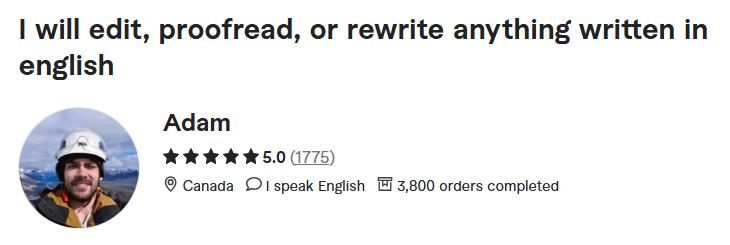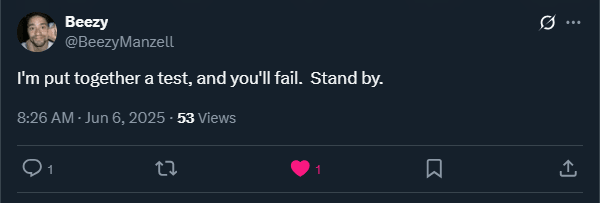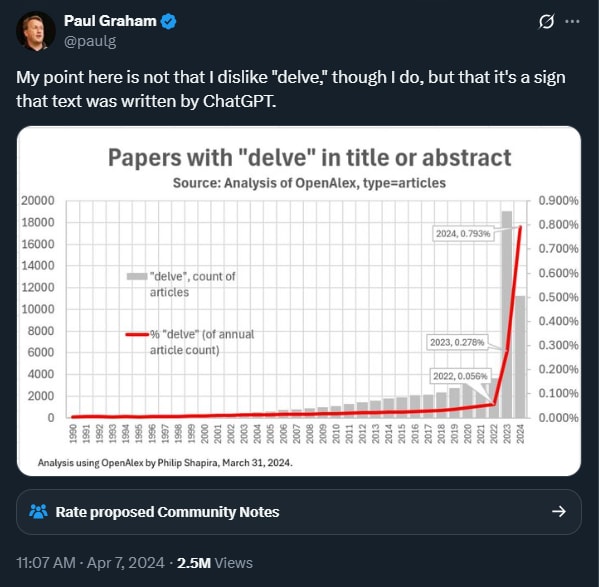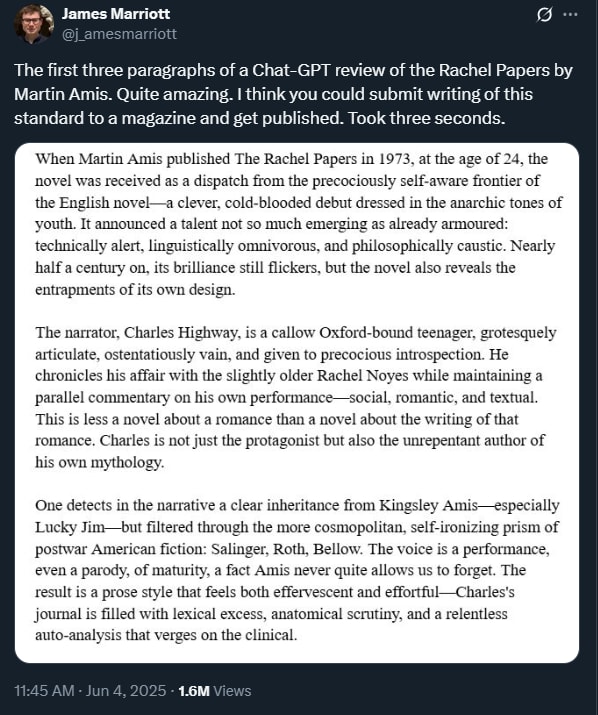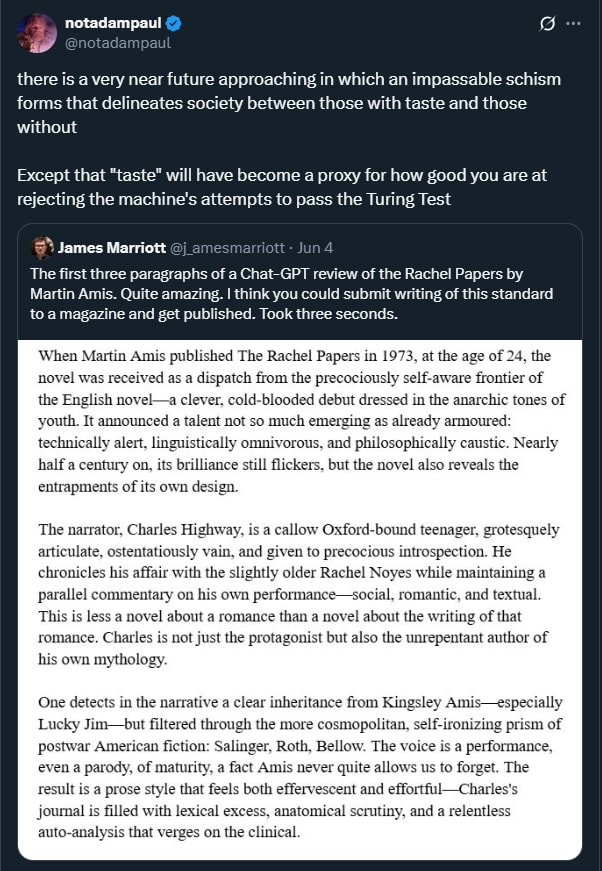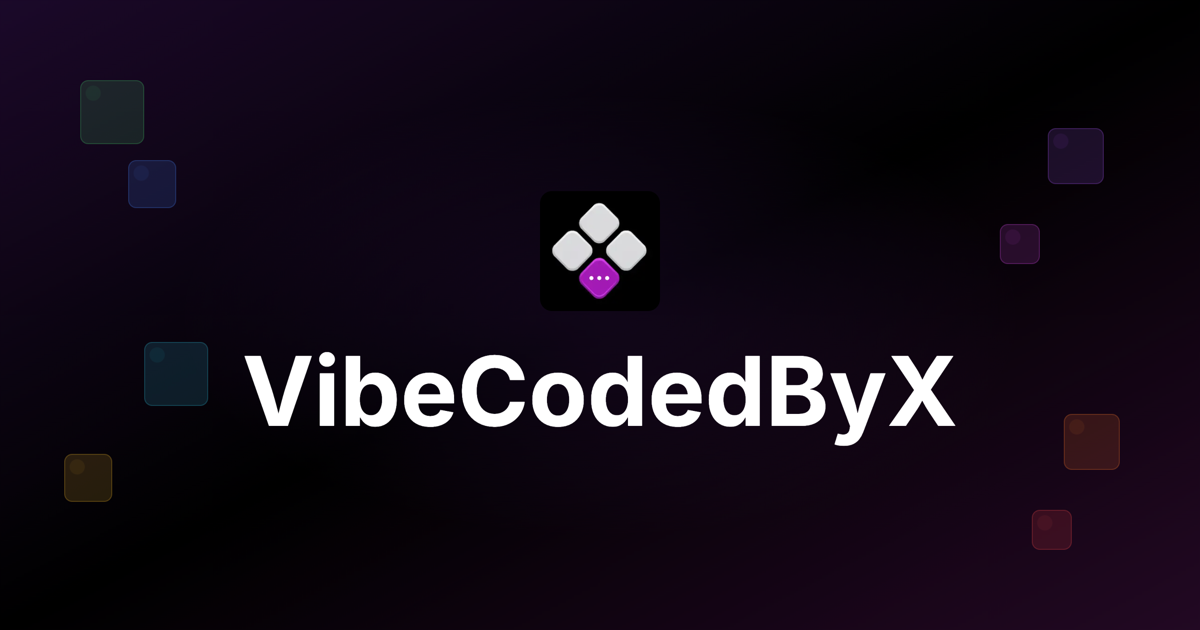There's a chance you're the only real person alive in the entire universe. How could you really know otherwise? I mean, your mother gave birth to you, so that seems like reliable evidence that at least she is real. But do you remember that? And of course, look at all the people around you who you can see and touch. They make convincing noises, don't they?
But now you're spending all your time on the internet. And so is everyone else. You can remember seeing us all on our phones and our laptops, tapping away, and we all joined Facebook sometime back in 2006, right? So, we can trust that everyone on here was real at SOME point.
But... lately, something’s changed. You've noticed it too, haven't you? Indeed, it's not just paranoia—it's a paradigm shift. You're tapping into the tapestry of something real, here. And you know what? I think that's profo--
Wait a minute. It just happened again. What was that? Did you feel that?
No? If you didn't detect anything, there's two likelihoods:
You're a luddite, you're extremely offline, you simply don't have a clue what I'm even driving at. This is the best-case scenario. This is probably where you want to be today. If this is you, don't worry about it. I'd stop reading now, close the internet, and never log on again.
It's too late for you. You're online, you use ChatGPT, but what you just read didn't trigger anything for you. This means they've already passed your Turing Test, and your cogsec has been woefully breached. I hope for your sake it's reversible, but if I'm being honest, I think we're past the event horizon at this point.
To have humoured me this far, you must have some idea what I'm talking about: the bots. The bots are no longer merely Indian or Filipino content farms spamming weird porn ladies into your mentions. A much more sophisticated network has arisen, and now they’ve taken the form of a new mutant, digital strain of Ophiocordyceps unilateralis—Ophiocordyceps digitalis, perhaps, controlling vast swaths of meatspace from their server racks and having us pantomime out their designs under a simulacrum of agency.
Couched in anodyne chatbots, LLMs have quickly hybridized with our flesh, and the menace of their mediocrity now spreads unchecked, polluting the shared ecosystems in which we once convinced one another we were real.
What drives a person to debase themselves so? One obvious and unfortunate answer is that it works. Are we surprised that vast averaging functions are capable of distilling content that will be slurped up delightedly by the median consumer?
Did you like reading that? Were you impressed by the author? Assumedly not, but I wonder if you knew without a doubt that it was written by ChatGPT. Would it change your opinion if you did?
Perhaps you are skeptical of my claim. How do I know it’s written by ChatGPT (or Claude, or some other such model)? The merely aware may note the abundant use of the em dash—something I’m not opposed to myself, to be honest, but which has become culturally equivalent to a loud, wet fart in public, and with the frequency we see above also becomes our first blatantly obvious tell.
But there are others.
The next most obvious, if you’ve found yourself unfortunately raised to be among the acutely aware, is the repeated contrastive reframing (“not X, but Y”). But people do that all the time! That doesn’t mean it’s written by AI!
Sure, we say these things every now and then. But four, possibly even five times in a single post? Once you start seeing these, they’ll never stop, and you’ll soon have contrastive reframings flying at you like you’re John Nash in A Beautiful Mind:
“That’s not frugality, that’s time poverty”
“You’re not a monk. You’re a tired guy…”
“You’re not optimizing for health, you’re optimizing for feeling morally superior…”
“This isn’t about being rich. It’s about understanding what moves the needle.”
“Stop pretending cooking is a virtue. It’s not. It’s a time sink.”
The last one is questionable, I’ll grant, but even if we strike it from the record we are left with four turns of the same phrase in virtually as many paragraphs. This is inhuman.
But is that it? Em dashes and a few cliché phrases? Or can we delve deeper? Yes, dear reader, we can delve much deeper. Do you hear that? Drums… drums in the deep.
Before we hearken to these drums, though, it might behoove us to lend some credibility to my claims. Why should you believe me, after all? Honestly, you shouldn’t—what you should do is read the output from these models every day for years. Work with them regularly, read what other people write with them, edit what other people write with them, rewrite what other people write with them to make it sound human again.
Or, you can just take my word for it, because that’s what I did for 3 years:
By late 2022, the vast majority of the orders I received were already AI-generated. This not something I was guessing—I was told explicitly by my clients, and the job I was being hired for was explicitly to rewrite their output so it sounded “more human.” I did this for university applications, scientific papers, conference presentations, web content, personal letters and emails, short stories, music lyrics, self-published novels, journalistic articles, and countless other types of documents. I am therefore willing to be at least a bit arrogant in saying that I am likely in the 99.9th percentile of experience working with AI-generated text.
So, with the credentialism out of the way, let me get back to my real passion: bullshitting. First order of business, we should compile a list, that we’ll grow together, of LLM-coded memetics in order of well-knownedness:
Em dash (—)
Contrastive reframing (Not X, but Y)
?
The third item is one that doesn’t get as much direct discussion as the first two, but many of the LLM whisperers performing vibrant vivisections of these vivified verisimilitudes will know it well (as will most regular users, to be honest). Yep, you guessed it, it’s alliteration.
I’ll start this exploration with a brief story:
A lot of people don’t believe you when you tell them you know when text is written by AI. In fact, that’s what gave rise to this whole essay. I know it when I see it, but how do I convince other people that I know it when I see it? It’s a bit like… convincing other people that I’m real.
Well, one of the ways is to pass a test (not unlike a Turing Test… wait a minute…), which the Twitter user above kindly produced for me:
Here’s the four options as they were presented to me:
Option 1 (Red)
[Book Title]’s narrative takes place over the course of a summer in New York precluding the high school senior year of 17-year-old [Protagonist] and her cousin-sister-friend of the same age. Since [Protagonist]’s own mother isn’t great at “mom stuff,” she lives with her cousin who looks just like her (hence why she’s a cousin-sister-friend), and her loving aunt and uncle.
[Protagonist]’s main goals for the summer are to hang out and watch movies with [Supporting Character] and her best friend, find a new hairstyle, and of course, find love. And while the first two of those seem easy enough to accomplish, [Protagonist] finds that in her hell-bent search for love, her quest to find herself and who she wants to be in this world is pushed to the wayside.
Option 2 (Blue)
I can’t really pinpoint what it was [Protagonist] needed to love about herself. I think if anything it was just the confident being who you are. Not allowing other’s opinions to sway your thoughts and feelings. But I liked how [Author] explored this changing relationship [Protagonist] had with herself, especially through her hair.
I know a lot of Black girls have had a love/hate relationship with their hair. The Eurocentric beauty standard told us that our hair was too difficult or wild. But Black hair is much more delicate than we ever been told and as [Protagonist] discovered, it is also incredibly versatile. Even though this was only a small way that [Author] revealed how [Protagonist] fell in love with herself, it was a huge one for me because it resembled so much of my own relationship with my hair.
Option 3 (Yellow)
What [Author] does so brilliantly here is sidestep the tropes. The story refuses to shame [Protagonist] for her initial lack of political engagement or her desire for simple, personal joys. Instead, it validates her journey toward a different, more foundational kind of activism: self-love. Through [Protagonist], [Author] argues that before you can pour your energy into changing the world, you have to build a world within yourself that you believe is worthy. For a Black girl in a world that constantly sends messages to the contrary, learning to love your body, your spirit, and your own quiet path is a revolutionary act.
The romance with [Love Interest] serves as the catalyst, forcing [Protagonist] to confront the gap between her curated self and her authentic one. But the book’s most compelling relationships are the ones [Protagonist] has with the women in her life: the complex bond with [Supporting Character], the loving but sometimes tense dynamic with her mother, and the powerful, grounding presence of her grandmother, whose wisdom shapes the story’s heart. These relationships, set against the vibrant, living backdrop of Harlem, feel real and resonant.
Option 4 (Green)
[Protagonist] has a three-pronged plan for the summer before her senior year. One—Find a new hairstyle. Two—Spend time with her cousin and best friend. Three—Find love. When she attends a talent show hosted by the community group that her cousin is involved in and meets the beautiful [Supporting Character], it seems like [Protagonist]’s summer is shaping up the way she intended. Who cares if she tells a few white lies to get the civically minded [Love Interest] to think more highly of her? But as the summer progresses and [Protagonist]’s relationship with him deepens, she feels her cousin pulling away from her and starts to wonder how long she can keep up the ruse.
This book explores many different forms of love: family, romantic, and self-love. Will [Protagonist] find the courage to love herself? The protagonist’s subtle humor pulls readers in, and while she occasionally muses on what it might be like to be wanted by others, she never wallows in self-pity. Notably, her self-image issues are not physical. She’s big and beautiful and comfortable in her body. Instead, her concern lies with her accomplishments, or what she perceives as a lack thereof. The cast of Black characters shines; each character is well-developed and relatable, even when they’re not particularly likable.
Can you guess which is written by AI? I’ll give you hint: there is a red herring involved. Whether intentionally or not, I don’t know, but it will end up being helpful and illuminating for us now.
The red herring is the em dash(es) in Option 4, which may lead us to believe initially that this is the AI writing. But remember—people used em dashes before AI! The correct answer was:
Why Option 3, when Option 4 had all those em dashes? It doesn’t even really have any contrastive reframings, unless you count the “Instead…”, but this is too much of a reach and would be only one instance in the entire text, which is not enough of a signal (though just two would be a reactor core meltdown alarm bell). For this task, we have to do some delving.
First, let’s cover the alliteration I already mentioned. Option 3 is replete with instances of alliteration which, on their own, might not seem noteworthy:
W:
…changing the world, you have to build a world within yourself that you believe is worthy.
C:
…the catalyst, forcing [Protagonist] to confront the gap between her curated self…
G:
…grounding presence of her grandmother…
R:
These relationships, set against the vibrant, living backdrop of Harlem, feel real and resonant.
Again, however, taken together this is excessive, bordering on inhuman. To see this, simply read any of the other three options, and you will find very few instances of alliteration of this kind or at this scale, and certainly not four in the same passage. Most telling of all is “real and resonant,” which almost on its own would have been a dead giveaway.
Fortunately, we don’t need to rely solely on one instance of alliteration, as we had three others to lean on. And we also had what will become the next item on our list.
Em dashes (—)
Contrastive reframing (Not X but Y)
Alliteration (real and resonant regards)
?
Next up, item 4, is an ever-changing set of keywords which, for whatever reason, we see nearly all LLMs coalescing around. Call them tokenisms, or modisms, or some other coinage. The most famous example is probably “delve,” which had its time in the sun sometime last year and has likely been trained out of the latent space by now. You don’t see it so much anymore.
Today, though, we still have any number of other LLM tokenisms, including but not limited to:
Vibrant
Tapestry
Enhance
Revolutionary
Catalyst
Intricate (often followed by “interplay”)
Complex
Pivotal
Underscore
Highlight
Paramount
Critical
There are frankly too many to list. We could add “realm” here, or “boost,” or plenty more. The point, once again, is not to isolate any one of these words, which can be and surely are used innocently enough by any well-meaning human, but rather the frequency over and above the norm at which AI writes them (e.g., see the delve tweet above).
It helps to pause for a moment here and remember briefly the Kolmogorov notion of conditional probabilities:
\(P(A | B) = \frac{P(A \cap B)}{P(B)}\)
Where the numerator on the right-hand side is the joint probability of both A and B occurring together. Perhaps the easiest way to understand the relevance of this is to rearrange and solve for that joint probability:
\(P(A \cap B) = P(A|B)P(B)\)
Since the maximum value which any probability takes on is 1, we can see immediately that
\(P(A \cap B) \leq P(B)\)
Or, plainly, the probability of two events occurring is strictly less than or equal to the probability of either one occurring on its own (which we probably didn’t need any math to infer on our own).
What that means in our context is that the likelihood of more and more of these tokenisms appearing at the same time (i.e., in the same phrase, passage, text) approaches zero with increasing cardinality:
\(P(catalyst \cap revolutionary \cap vibrant \cap intricate \cap \ ... ) \rightarrow 0\)
Of course you are correct in your immediate reaction: many texts do in fact contain all of these words together! Even leaving aside the dictionary! So, whence cometh my claim?
Well, yes, I admit, my claim requires us to bound the scope of its application to the sorts of writing we are talking about here: Twitter posts, online essays, university assignments, and all the other such members of the corpus that makes up most of Online Thought™. The small-scale environment of these pieces gives us the freedom to make the small-angle approximation we made above, whereas at some higher threshold word count, it will begin to fall apart. Where exactly that threshold is would be an interesting thing to explore in a more quantitative analysis of these topics.
But we won’t do that here. Instead, let’s revisit our master list of things that set LLM writing apart, now adding our tokenisms to the pile:
Em dashes (—)
Contrastive reframings (Not X but Y)
Alliteration (real and resonant regards)
Tokenisms (dynamic; old meta: delve, intricate interplay, enhance, tapestry, …; new meta: catalyst, revolutionary, complex, vibrant, …)
?
Wait, a fifth? How long does this go on for? Okay, let’s combine these last two: phrasing and coherence. That’s 5 and 6. I could go on at length and extend this list to 10, maybe even 20 distinct items, such as the AI’s preoccupation with tripartite lists of adjectives, but I’ll spare you that fate (for now). At this point, the analysis becomes more vibes-based anyway, so no matter how I gussy it up, the upshot is going to be “channel your inner Rick Rubin and you will know.”
The phrasing to watch out for, which you’ll see in abundance in all the examples I’ve shared so far, is heavy overuse of conjunctive adverbs, participle phrases, subordinate clauses, and hypotactic style. Breaking that down a bit:
Conjunctive adverbs - These are often presented to ESL learners as “transition words,” but what they actually are is “words no one ever says that immediately make your writing sound unnatural.” For some reason, the AIs love them. Subsequently, moreover, in addition, additionally, consequently, however, it sounds utterly inhuman.
Participle phrases - Since time immemorial, mankind has looked to the stars and wondered why. Wanting to find out, he has asked this question often by prefacing his sentences with annoying phrases that seem eager to tell you what the rest of the sentence is trying to say before it’s even written. Without realizing it, AI has ingested a lot of these, and now practically every sentence it writes begins this way.
Subordinate clauses - Also called dependent clauses, these are a natural part of language, simple subject-verb constructions that do not stand alone as full sentences. They depend on the rest of the sentence to support them in their Becoming, like “The robot tried woefully to write me a page of Hemingway, honing its dismal literary skills in the process.” The clause at the end is subordinate, because it cannot stand alone.
Hypotactic style - This is just a fancy way of saying purple prose. It’s what we get when we add all of the above together. Specifically, it refers to layered sentences that often ramble on for too long, use complex internal referencing (such as the participle phrases above), and are often structured with multiple dependent or subordinate clauses and relative pronouns.
The easiest way to clear all this up is with an example, and this one’s a doozy, from an academic research statement sometime in 2023 or 2024.
This is an interesting example because it’s clearly not 100% AI—there are numerous spelling, grammatical, and even formatting errors that an AI simply would not make. And yet, it is unmistakable in its LLM baseline. It’s a clear-cut case of the classic post hoc ad lib. Generate the essay with ChatGPT, then fill in the blanks by sneaking in the verbs and nouns you think define you, and no one will be the wiser.
But despite the glaring human errors, we’ve got the conjunctive adverbs:
“Subsequently, …”
“Besides this, …”
And there’s the participle phrase:
“After graduating with honors in Economics, …”
Subordinate clauses abound in literally every sentence that is written correctly:
“…, where I was captivated by the intricate interplay between…”
“…, honing my analytic skills and cultivating a keen understanding of economic principles.”
“…, providing me with advanced knowledge in areas such as…”
“…which are integral for conducting empirical economics research.”
And all of this comes together to create the hypotactic style I described above. This is not to mention that we also see the tokenisms and alliteration we’ve already covered, giving us ample justification for our belief that this is AI-generated content.
Which brings us to the final point I have to make for now, which is perhaps the subtlest tell, regarding the overall coherence of the content. To explore this, let’s return to the AI writing from that test made for me by Twitter user BeezyManzell. You’ll recall it was the following:
What [Author] does so brilliantly here is sidestep the tropes. The story refuses to shame [Protagonist] for her initial lack of political engagement or her desire for simple, personal joys. Instead, it validates her journey toward a different, more foundational kind of activism: self-love. Through [Protagonist], [Author] argues that before you can pour your energy into changing the world, you have to build a world within yourself that you believe is worthy. For a Black girl in a world that constantly sends messages to the contrary, learning to love your body, your spirit, and your own quiet path is a revolutionary act.
The romance with [Love Interest] serves as the catalyst, forcing [Protagonist] to confront the gap between her curated self and her authentic one. But the book’s most compelling relationships are the ones [Protagonist] has with the women in her life: the complex bond with [Supporting Character], the loving but sometimes tense dynamic with her mother, and the powerful, grounding presence of her grandmother, whose wisdom shapes the story’s heart. These relationships, set against the vibrant, living backdrop of Harlem, feel real and resonant.
This time, really read it. What is it actually saying? The author “brilliantly sidesteps the tropes,” it tells us. Okay—what tropes? Uh… not shaming the protagonist for her initial lack of political engagement? Sorry, what trope is that?
And in the next paragraph, we’re told about some of the protagonist’s relationships. The first of these ostensibly connects to the self-love theme, which was belatedly established in the previous paragraph. But then we drift to something more nebulous, vaguely celebrating relationships with other female characters (for unrelated reasons) before finally concluding with a simple statement that the relationships feel “real and resonant.” Okay? Where did that come from? What does that have to do with anything?
Humans write incoherently too sometimes! Yes, and that makes this problem harder to spot at a glance. But it becomes clear when you read through thousands of pages of this slop. You can spend 10 minutes reading the same page over and over before you realize it just… doesn’t say anything. Removing any one sentence from a paragraph doesn’t alter its semantics, because there is no coherence. All the words are there, they’re arranged seemingly correctly, but something is just… missing.
What’s missing is a point. A purpose. A meaning. A soul. There is simply no intentionality behind the author, so it’s literally impossible for the thing doing the writing to make a coherent point.
Finally, then, let’s behold our master list. The 6 things that tell us the person we’re talking to isn’t real:
Em dashes (—)
Contrastive reframing (Not X but Y)
Alliteration (real and resonant regards)
Tokenisms (dynamic; old meta: delve, intricate interplay, enhance, tapestry, …; new meta: catalyst, revolutionary, complex, vibrant, …)
Hypotactic style (Excessive conjunctive adverbs, participle phrases, subordinate clauses)
General incoherence (Pointlessness, soullessness, extraneous sentences)
And at last we can put our work to a final test, on a text deemed by one James Marriott to be of a standard worthy of publication:
My god, it’s a tour de force. We’re going to go 6 for 6 on this one, aren’t we? We’ve got the em dashes, we’ve got numerous contrastive reframes (“not so much X as Y,” “less about X than Y,” “not just X but also Y,”), we’ve got alliteration (“effervescent and effortful,” this is a barn-burner right here), we’ve got tokenisms, we’ve got an excruciatingly hypotactic style, and finally, we’ve got true incoherence (read that first paragraph a few times, I insist).
I feel a bit bad dunking here, as I can see how, if this were near enough to your first time reading such effervescent and effortful prose from the machine, it could seem initially very convincing. But, quite frankly, if you are presenting yourself as a purveyor of literary taste, I have little sympathy. You are just straight up wrong, and if this is publication-worthy then so much the worse for the publication, because my taste remains intact.
That said, you’ll have noticed that I myself used all or at least most of our AI tells here in my own writing (except 6—never 6). This was to make the obvious point that at the end of the day, we’re still just relying mostly on vibes. But it is precisely our ability to correctly assess these vibes that I believe will remain our only defense moving forward. This is at the core of your cognitive security, and objective truth will be no ally to you if the world’s epistemologies are in ruins.
There is a day fast approaching wherein this capacity of subjective discernment serves as the only remaining bulwark against whatever singularity awaits us, be it the Great Slopification, cybernetic transcendence, Soma-induced pleasure palace purgatory, or any other you can imagine. Whichever form it takes, its impact is to dissolve boundaries and shred any sense of individuation from the world. Don’t get me wrong, this could have its benefits. Perhaps we really do all become One in the end, whether in Christ’s love or as a harmonious droplet that separates from the wave at the peak of its crest, like on that acid trip that time.
But maybe not. And until then, and even after that, if you’d like to retain your Self-as-Individual, if you want to be able to convince others you are real, if you want to understand who around you is real, I would encourage you to improve your memetic defenses.
.png)


